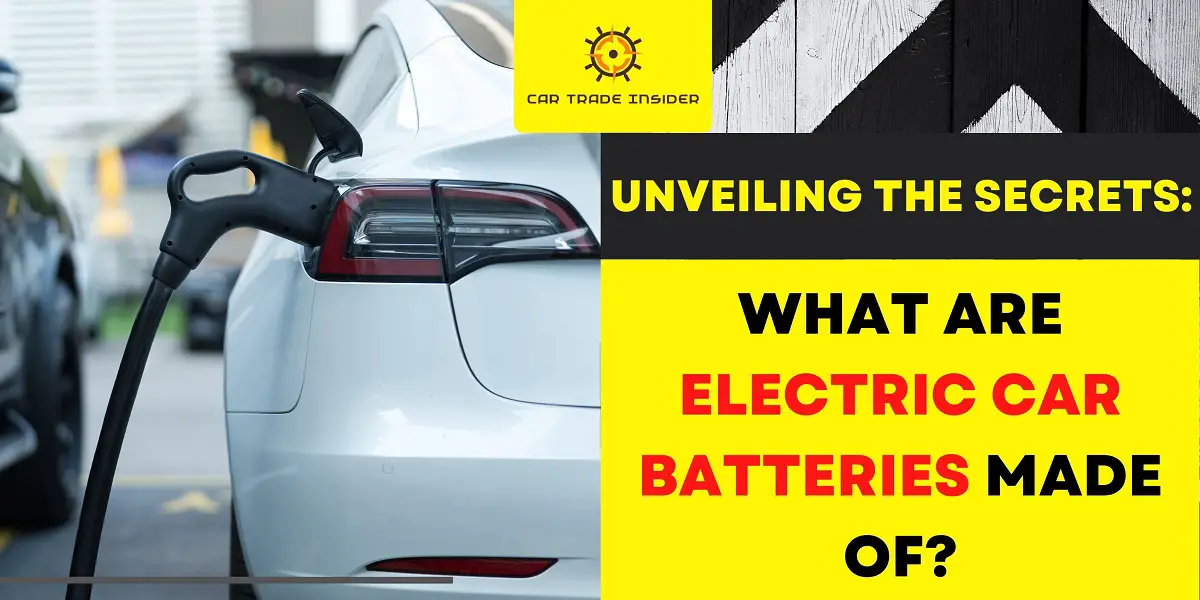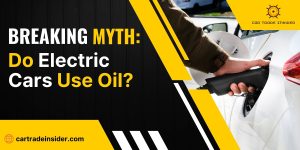Electric car batteries are primarily composed of lithium-ion cells containing materials such as lithium, cobalt, nickel, and manganese. Lithium-ion cells are the most popular because of their cost efficiency, offering the most optimal trade-off between energy storage capacity and price.
Sales of battery-electric vehicles and plug-in hybrids saw strong growth in the third quarter. The EV market generated $561.3 billion in 2023. EV sales exceeded 1 million for the first time in September.
Governments like the US, China, and the EU are pushing for increased EV adoption, with targets ranging from 40% to 50% of all new car sales by 2030. Just like you need food to keep your body moving, electric cars need batteries to keep them rolling.
But these aren’t just any batteries you’d find in your TV remote or your game controller. In this article, we’re going to dive into the fascinating world of electric car batteries. We’ll uncover what are electric car batteries made of and how they’re put together.
The Basics of Electric Car Batteries:
Electric car batteries are like the powerhouses that fuel electric vehicles (EVs) instead of traditional gasoline or diesel engines. While regular cars rely on fuel to generate power, electric cars use batteries to store electricity, which then powers an electric motor to drive the wheels.
Unlike traditional vehicles, electric cars eliminate the need for oil changes and reduce dependence on fossil fuels, offering a more sustainable transportation option.
A typical EV battery pack contains about 8 kilos of lithium carbonate, 35 kilos of nickel, 20 kilos of manganese, and 14 kilos of cobalt. These materials work in harmony, each playing a crucial role in storing and releasing energy efficiently.
Types of Batteries
- Lithium-ion (Li-ion): These are the most common and versatile batteries, offering a good balance of performance and cost.
- Nickel Manganese Cobalt (NMC): Known for their high energy density, these batteries are great for longer driving ranges.
- Nickel Metal Hydride (Ni-MH): Often used in hybrid cars, these batteries strike a balance between performance and affordability.
- Lithium Sulphur (Li-S): These are still in development but promise even higher energy density than Li-ion batteries.
- Lead-Acid: Typically found in older vehicles, these batteries are less efficient but still get the job done.
Battery Shapes and Sizes
- Cylindrical: These batteries are like small tubes and are often cost-effective and easy to manufacture.
- Prismatic: Rectangular, these batteries offer good energy storage and power delivery.
- Pouch: These batteries are flexible and space-efficient, making them great for fitting into different vehicle designs.
Each type of battery and format has its strengths and weaknesses, catering to different needs and preferences in electric vehicles.
Key Components of Electric Car Batteries:
The chemistry of EV batteries varies, with lithium-ion being the most common due to its affordability and high energy storage capacity. Other notable chemistries include nickel manganese cobalt (NMC), nickel metal hydride (Ni-MH), and lead acid.
Lithium-ion batteries consist of layers comprising a cathode (typically lithium, nickel, cobalt, and manganese), an anode (commonly graphite), and an electrolyte, all encased in aluminum or steel for protection.
- Anode: The positive electrode, storing lithium ions during charging.
- Cathode: The negative electrode, receives and releases lithium ions during charging and discharging.
- Separator: Ensures ions flow between the electrodes without direct contact, preventing short circuits.
- Electrolyte: Facilitates the movement of lithium ions between electrodes during charging and discharging.
- Lithium Ions: The key players in storing and releasing electrical energy within the battery.
Manufacturing Process of Electric Car Batteries:
The production of electric car batteries involves several intricate steps, starting from the manufacturing of individual battery cells to the assembly of battery modules and packs.
Step 1. Electrode Material Preparation:
Raw materials such as lithium, nickel, and cobalt are sourced and processed to create cathode and anode materials. These materials undergo mixing, coating, and drying processes to form electrode sheets with precise compositions and thicknesses.
Step 2. Cell Assembly:
Electrode sheets are stacked together with separator materials in between to form a cell “jellyroll.” The jelly roll is then inserted into a cylindrical or prismatic casing and filled with electrolytes. Sealing the casing completes the cell assembly process, creating a sealed unit ready for testing.
Step 3. Quality Control:
Cells undergo rigorous testing to ensure they meet performance and safety standards. Tests may include checking voltage, capacity, and internal resistance, as well as conducting safety tests under various conditions.
Step 4. Module Assembly:
Multiple cells are grouped to form modules, typically arranged in series or parallel configurations. Modules may include additional components such as thermal management systems and battery management electronics.
Step 5. Pack Assembly:
Modules are assembled into packs, which are the final building blocks of the battery system. Packs may undergo additional testing and integration with other vehicle components before installation into the electric vehicle.
Step 6. Final Quality Checks:
Completed battery packs undergo comprehensive quality checks to ensure they meet performance, safety, and reliability requirements. Any defective or substandard packs are identified and rectified before installation into electric vehicles.
Components of an EV Battery
Beyond the cell materials, EV batteries require additional components for functionality:
- Battery Module Array: Groups of cells wired together to form modules, which collectively make up the battery pack.
- Battery Management System (BMS): Controls and regulates the battery’s performance, ensuring optimal operation and safety.
- Battery Electrical System: Includes wiring and electrical components necessary for the battery’s operation.
- Battery Cooling System: Manages heat generated during operation to prevent overheating.
- Battery Protection Case: Provides physical protection and structural integrity to the battery pack.
Environmental Impact and Sustainability:
Despite their eco-friendly reputation, the production of EV batteries raises sustainability concerns. The extraction of materials for EV batteries, including cobalt, nickel, and lithium, often involves environmentally damaging methods.
For instance, extracting one ton of lithium consumes nearly 500,000 gallons of water, highlighting the urgency for more sustainable practices.
However, ongoing efforts are underway to develop more sustainable extraction methods and reduce the industry’s ecological footprint. In response to these challenges, researchers and companies are pioneering innovative solutions.
Energy X, for instance, has developed Direct Lithium Extraction (DLE), a more sustainable method that yields higher lithium output at a fraction of the cost and environmental impact. Such advancements offer hope for a greener future in battery production.
Global Supply Chain:
China currently leads the charge in lithium-ion battery production for electric vehicles, supplying a significant portion of the global demand. However, governments worldwide are prioritizing the development of domestic supply chains to ensure resilience and autonomy in the face of increasing EV adoption.
Major players in EV battery manufacturing include CATL (34% of the market share), LG Energy Solution (14% of the market share), and BYD (12% of the market share). Efforts are underway globally to boost domestic production and mitigate supply chain challenges
Countries such as the Democratic Republic of Congo, Indonesia, Australia, and nations in South America are significant sources of cobalt, nickel, and lithium—essential materials used in EV batteries.
- Cobalt: Half of the world’s cobalt originates from the Democratic Republic of Congo, a crucial player in the battery supply chain.
- Nickel: Indonesia, Australia, and Brazil contribute to the global nickel supply, essential for enhancing battery performance.
- Lithium: South America, particularly Chile, Bolivia, and Argentina, holds the lion’s share of lithium reserves, vital for powering electric vehicles.
However, it’s important to diversify supply chains by sourcing materials from various regions. Relying too heavily on specific countries for these materials can create vulnerabilities in the supply chain, such as geopolitical risks, trade disruptions, or fluctuations in commodity prices.
The Rise of Solid-State Batteries:
Solid-state batteries offer a promising solution for electric vehicles, aiming to overcome the limitations of traditional lithium-ion batteries. These batteries utilize solid ceramic materials instead of liquid electrolytes, promising lighter, cheaper, and faster-charging alternatives.
Collaboration between automakers, battery manufacturers, and technology firms is driving research and development efforts to accelerate the adoption of solid-state batteries for EVs.
Solid-state batteries cut carbon emissions by 40% and offer over 500 miles of driving range on a single charge. BMW and Ford are among the pioneers testing solid-state batteries for potential integration into vehicles by 2025.
Toyota showcased a solid-state EV battery with a 745-mile range and signed a deal to mass-produce solid-state batteries with a 932-mile range in October.
Conclusion:
Electric car batteries are the driving force behind the green revolution in transportation. By understanding their composition, environmental impact, and technological advancements, we pave the way for a cleaner and more sustainable future on the road.
So next time you hit the accelerator in your EV, remember the powerful technology that propels you forward into a greener tomorrow.




